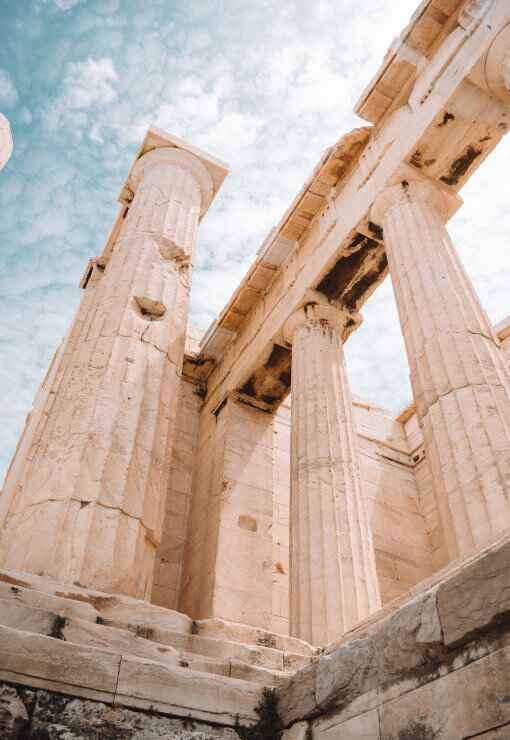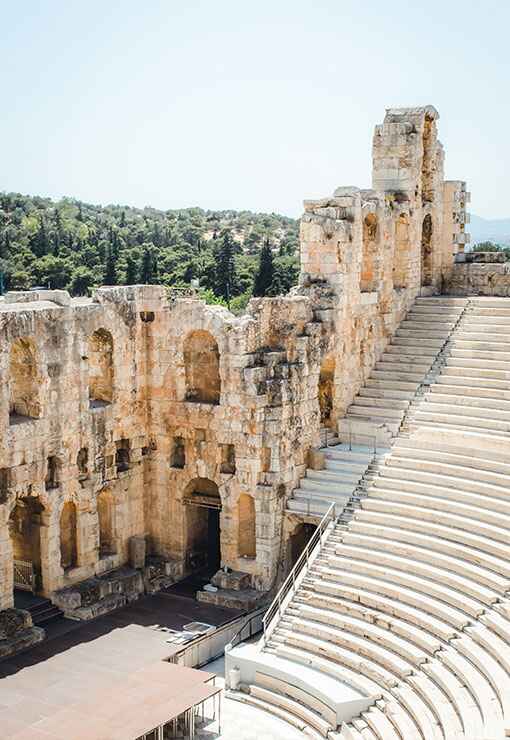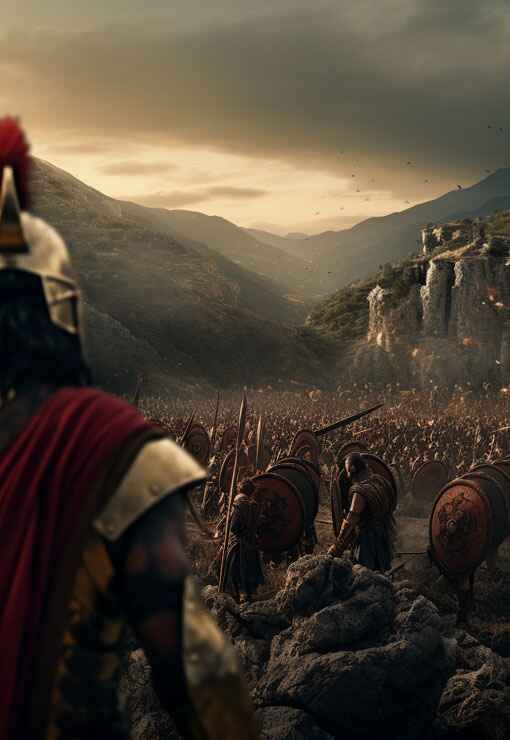

Greece sits at the crossroads of three continents; to the east across the Aegean is Asia, Africa is on the southern coast of the Mediterranean and Europe lies north. This physical location brough the people in contact with many others over the millennia and Greece is shaped by its physical environment. Humans have lived there since at least the Middle Paleolithic (Old Stone) Age c 55,000-30,000 BC. These early inhabitants lived by hunting, gathering of wild plants, using finely crafted tools and weapons made from wood, stone and bone.
At the end of the Ice Age, when the glaciers that had covered much of Europe were receding c 12,000 BC, the climate of Greece warmed considerably. In the process, the landscape and its plants and animals evolved into their present forms.
Early in the Neolithic (New Stone) Age c 6500-3000 BC the people learned to cultivate wild cereals and other plants and to domesticate animals, beginning the farming and herding economy that was to be the mainstay of Greek life till the modern era. Small farming villages sprang up, made up of one-room mud-brick houses. The villages grew larger and new village communities were formed.
Nearly four thousand years after the adoption of agriculture, another fundamental technological innovation was introduced. The technique of adding tin to copper to produce bronze came to Greece around 3000 BC and heralded the start of the Early Bronze Age (c 3000-2100 BC). By about 2500 BC, the use of bronze and other metals such as lead, silver and gold had become widespread across mainland Greece and the Aegean. Tools and weapons made of bronze were considerably more efficient than those made of wood, stone and bone. It was a turning point in Greek social history as high-ranked families and individuals, those with greater surpluses of wealth had more access to these items, setting them apart from the general mass of the population. As the economy expanded and the settlements grew larger, so did the wealth, power, and authority of their leaders, now established as hereditary chiefs ruling for life and accorded exceptional honours and privileges. The two major civilisations which arose in the Aegean Bronze Age are the ‘Minoan’ on the island of Crete and the ‘Mycenaean’ in mainland Greece.
During the Middle Bronze Age c 2100-1600 BC, Greece entered what appears to have been a period of cultural stagnation and the archaeological record is sparse. There is evidence of severe destruction at almost all the sites throughout mainland Greece and the islands. This put a halt to the progresses made in the Early Bronze Age.
The Middle Bronze Age recession had less impact on the island of Crete which was separated from the mainland. It was in Crete that Bronze Age Aegean culture reached its greatest height. In modern literature the culture of Crete is referred to as the ‘Minoan’ culture (after the island’s legendary King Minos). A distinctive Minoan civilisation emerged c 3000 BC. The most important city on the island was Knossos and the Greeks referred to its majestic palace as ‘King Minos’ Labyrinth. Around 2000 BC, the first huge multiroom complex, what we now call a palace, was completed at Knossos. There were other urban centres, at Mallia to the east and at Phaistos near the south coast. At each centre, there was a palace made up of a vast complex of rooms with paved corridors and stone stairways, grouped around a central court.
The Mycenaean civilisation on the Greek mainland came into existence c 1600 BC, coinciding with the Late Bronze Age. Around 1375 BC, an expedition of Mycenaeans crossed over to Crete and assumed control of Knossos and hence over the whole of Crete. The Minoan palaces were burned and looted leading to the irreversible decline of the entire Cretan economy. Crete had long been the dominant power in the Aegean world and the island was controlled from its palace centres. The Mycenaeans now took control of this empire.
The Mycenaean civilisation had its main centres in the Peloponnese (the southern part of mainland Greece) with centres at Mycenae, Argos and Pylos. The decipherment of their syllabic script, the so-called Linear B, has proved that, in the palaces at least, their language was an early form of Greek. During the Late Bronze Age (1600-1200 BC), the Mycenaeans ruled the Aegean world. Imposing palaces were built throughout southern and central Greece. As in Crete, the palace complexes were the administrative, economic and religious centres of small principalities. At the apparent height of its prosperity, the Mycenaean civilisation suffered a fatal blow. From around c 1200 BC, the palaces were consumed by fire, one by one. Entire towns and villages were razed to the ground or abandoned. The scale of the devastation was so severe that by the end of the twelfth century, the palace system had effectively vanished. We do not know what or who destroyed the Mycenaean palaces but with the end of the first stage of Greek civilisation came the beginning of a new era.
More than four hundred years passed between the fall of the Mycenaean civilization and the rise of Archaic Greece. Marked as a period of steep decline and slow recovery, during the Dark Ages (c 1100-750 BC), no monumental structures would be built in Greece, even the art of writing was forgotten and would not return till the eighth century. Supplies of bronze and other trade metals dwindled to a trickle as vital trade links were broken. All across the Greek world, towns and villages were left abandoned, their inhabitants either dead or gone to other places. It was a period of total obscurity coupled with utter poverty and stagnation. Despite this, there were some technological innovations. Around 1050 BC, the emergence of a superior pottery style called Protogeometric seems to have originated in Attica and spread to other regions (followed by the Geometric style (900-700 BC). It was also about this time that Greek metal workers mastered the difficult process of smelting and working iron. Iron weapons and tools were harder than bronze. Small local iron industries sprang up all across the mainland and the islands. By 950 BC, almost every weapon and tool found in graves is made of iron, not bronze.
In this inventive period appeared new forms of religious, artistic and poetic expression. 776 BC marks the date of the first Olympian Games. In place of the centralized, redistributive economies of the Bronze Age, eighth century Greeks relied on individuals to exchange goods as they thought best. Homer is our best source for knowing what the Greeks were thinking in the eighth century as they fought each other and sailed across dangerous seas to found new ‘poleis’. The two poems of the Odyssey and the Iliad are generally dated to between the later eighth and early seventh centuries BC, about the time writing reappeared in Greece.
Although there are hints of recovery in the ninth century, the Greek Dark Age continued until the eighth century and the city states that emerged were very different. During those obscure centuries, new social and political patterns were formed. It was in the Dark Ages that Greek society was born. The old Mycenaean world, despite the Greek language of the palaces, had its closest kinship amongst the states further east, in Northern Syria and Mesopotamia. The basic structures and institutions of later Greek society would be firmly in place well before 800 BC.
It is an accepted convention to divide the subsequent history of the ancient Greeks into the following three periods.
6000-2900 BC
According to historians and archaeological findings, the Neolithic Age in Greece lasted from 6800 to 3200 BC. The most domesticated settlements were in Near East of Greece. They traveled mainly due to overpopulation. These people introduced pottery and animal husbandry in Greece. They may as well have traveled via the route of Black sea into Thrace, which then further leads to Macedonia, Thessaly, Boeotia etc.
More2900-2000 BC
The Greek Bronze Age or the Early Helladic Era started around 2800 BC and lasted till 1050 BC in Crete while in the Aegean islands it started in 3000 BC. The Bronze Age in Greece is divided into periods such as Helladic I, II. The information that is available today on the Bronze Age in Greece is from the architecture, burial styles and lifestyle. The colonies were made of 300 to 1000 people...
More2000-1400 BC
Bronze Age civilization, centring on the island of Crete. It was named after the legendary king Minos. It is divided into three periods: the early Minoan period (c.3000-2200 B.C.), the Middle Minoan period (c.2200-1500 B.C.) and the Late Minoan period.
More1600-1100 BC
Period of high cultural achievement, forming the backdrop and basis for subsequent myths of the heroes. It was named for the kingdom of Mycenae and the archaeological site where fabulous works in gold were unearthed. The Mycenaean Age was cut short by widespread destruction ushering in the Greek Dark Age...
More1100-750 BC
The period between the fall of the Mycenaean civilizations and the readoption of writing in the eighth or seventh century BC. After the Trojan Wars the Mycenaeans went through a period of civil war, the country was weak and a tribe called the Dorians took over. Some speculate that Dorian invaders from the north with iron weapons laid waste the Mycenaean culture. Others look to internal dissent, uprising and rebellion, or perhaps some combination.
More750-500 BC
The Archaic Period in Greece refers to the years between 750 and 480 B.C., more particularly from 620 to 480 B.C. The age is defined through the development of art at this time, specifically through the style of pottery and sculpture, showing the specific characteristics that would later be developed into the more naturalistic style of the Classical period. The Archaic is one of five periods that Ancient Greek history can be divided into; it was preceded by the Dark Ages and followed by the Classical period.
More500-336 BC
Classical period of ancient Greek history, is fixed between about 500 B. C., when the Greeks began to come into conflict with the kingdom of Persia to the east, and the death of the Macedonian king and conqueror Alexander the Great in 323 B.C. In this period Athens reached its greatest political and cultural heights.
More336-146 BC
period between the conquest of the Persian Empire by Alexander the Great and the establishment of Roman supremacy, in which Greek culture and learning were pre-eminent in the Mediterranean and Asia Minor. It is called Hellenistic (Greek, Hellas, "Greece") to distinguish it from the Hellenic culture of classical Greece.
MoreAncient Greek art and architecture, with its harmonious proportions and timeless elegance, continue to inspire awe and admiration millennia later.
Discover
Greek mythology, a rich tapestry of gods, heroes, and mythical creatures, captivates the imagination with its tales of love, betrayal, and epic adventures that delve into the depths of the human psyche.
Discover
The ancient Greek Olympics, held in Olympia every four years, celebrated athleticism, unity, and cultural pride, serving as a testament to the enduring spirit of competition and excellence that transcends time and borders.
Discover
Ancient Greek wars, such as the Persian Wars and the Peloponnesian War, were pivotal conflicts that shaped the course of history, highlighting the struggle for power, independence, and the clash of civilizations in the ancient Mediterranean world.
Discover
Ancient Greek culture and society, characterized by its emphasis on art, philosophy, and civic engagement, fostered a vibrant intellectual and social landscape where innovation flourished, democracy thrived, and the pursuit of knowledge and excellence was celebrated as fundamental values of civilized life.
Discover
Ancient Greece is generally thought to have begun around 800 BC, during the Archaic Age, a period marked by the emergence of Greek city-states, the establishment of political institutions, and the creation of the Greek alphabet. Read more about The Archaic Era.
Find out more about ancientgreece.com